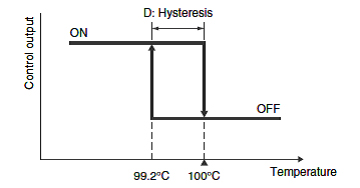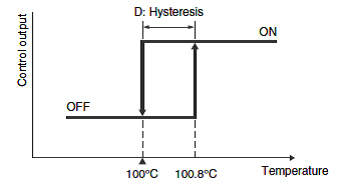Question
What is "Hysteresis"?
Answer
ON/OFF control action turns the output ON or OFF based on the set point. The output frequently changes according to minute temperature changes as a result, and this shortens the life of the output relay or unfavorably affects some devices connected to the Temperature Controller. To prevent this from happening, a temperature band called hysteresis is created between the ON and OFF operations.
Hysteresis (Reverse Operation)

Example:
If a Temperature Controller with a temperature range of 0 to 400°C has a 0.2% hysteresis, D will be 0.8°C. If the set point is 100°C, the output will turn OFF at a process value of 100°C and will turn ON at a process value of 99.2°C.
Hysteresis (Forward Operation)

Example:
If a Temperature Controller with a temperature range of 0 to 400°C has a 0.2% hysteresis, D will be 0.8°C. If the set point is 100°C, the output will turn OFF at a process value of 100°C and will turn ON at a process value of 100.8°C.
Setting a large hysteresis will cause the temperature at which the output changes from OFF to ON to be lower than the set point by the amount set for the hysteresis, causing users to sometimes think the output is not working according to the settings. (For Reverse Operation)
On the other hand, if the hysteresis is set to a small value, the output can chatter. The hysteresis thus need to be set to a suitable value.


